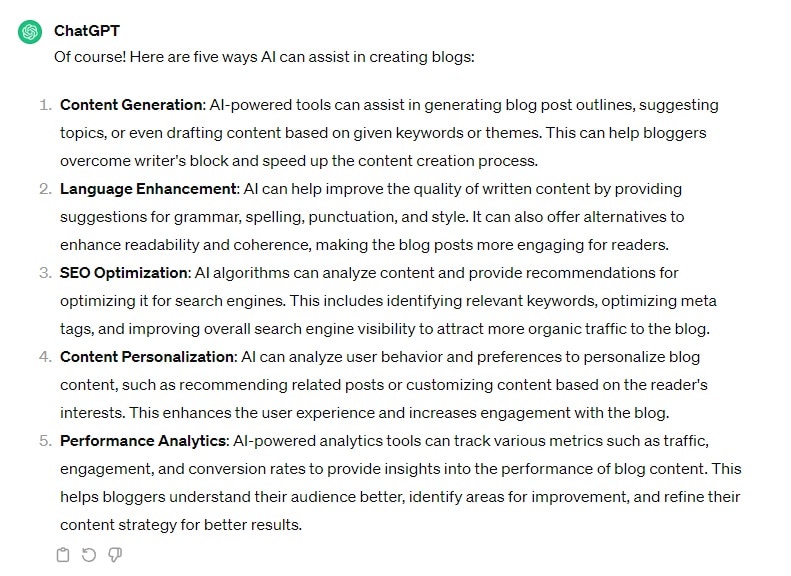
Standing Out in the Digital Noise: Unique Content Marketing in the Age of AI
STANDING OUT IN THE DIGITAL NOISE: UNIQUE CONTENT MARKETING IN THE AGE OF AI
It would be nearly impossible not to have heard about ChatGPT and the power of Artificial Intelligence (AI) tools in the creative landscape. Now, more than ever, AI is an essential tool in content marketing.
In fact, you might even have noticed that around the web there have been an increasing number of articles and blog posts that seem to have been written by a robot.
Right now, bots can only do so much. Sure, they can write content in a straightforward way, but somehow they haven’t figured out how to make it sound quite human. But make no mistake, the technology is developing fast and in the future AI will be able to make convincingly human-sounding content.
For the time being, though, AI simply offers us tools that make the creation of content easier and faster. This is especially useful in the realm of content planning and developing a content marketing strategy.
Let’s take a look at the topic of creating unique and valuable content in the age of AI.
The Role of AI in Content Creation
With all the proclamations that AI is taking over the world, it would be easy to think it is a recent invention. Not so. AI has been around for quite some time, as far back as the 1970s, when truly concentrated research began.
At the time, the only thing holding back development in the area was the lack of computing power.

Fast forward to the present day and computers can process and store the vast amounts of information that make programs like ChatGPT possible.
Fast forward to the present day and computers can process and store the vast amounts of information that make programs like ChatGPT possible.
As a result, AI now has the capabilities to use Natural Language Processing (NLP) to understand and analyze human language, to create written content, and to produce images using image recognition.
Nonetheless, as Stephen Jeske, a Senior Content Strategist at MarketMuse, notes, “We use the term AI because it’s more convenient, not necessarily because there’s anything intelligent [about it].”
AI is designed to analyze and process data, automate specific tasks, and generate outputs based on learned patterns. Simply put, AI is like any other tool: It’s there to save us time and hassle.
Human Creativity With AI Assistance
Most discussions around AI acknowledge the fact that although the technology is transforming media forever, it still needs a human hand to set it in motion.
For Jeske, AI is still just a tool in our toolbox: “You [need] skill to properly power the tool!”
Anything that is created by AI is done at the behest of a living, breathing person using prompts. Writing a prompt for AI is like writing a brief, except you have to be extremely specific and know exactly what you want it to do, which is one of the limitations of AI—right now.
A human is still needed to input what is needed and oversee and edit what AI spits out.
Thus, the most effective use of AI is not so much in creating content, but rather with it acting as a helping hand in the process. It is a powerful tool that can be put to use by content creators to automate repetitive tasks, double-check their writing, and research a given topic, among others.
By embracing this symbiotic relationship, content creators can focus on the parts of their work that require creativity and innovation, while leaving the tedious tasks to the computer.
I thin
A few ways in which content creators and marketers use AI are to:
- Write first drafts
- Generate content ideas
- Come up with plans and workflows
- Research and summarize ideas
- Research keywords
AI Tools for Content Creation

Do a quick Google search for AI tools and you will have a seemingly endless list of possibilities. However, some programs are remarkably useful, specifically within the sphere of content marketing. Here are a few that are essential to know about:
1. ChatGPT
Perhaps the most famous on this list and certainly the one that catapulted AI into the media spotlight, ChatGPT is fast changing how content is created.
Using NLP, users can interact with ChatGPT using natural language. In other words, you can ask ChatGPT a question and it will respond like a human would.
ChatGPT is a great tool to use to draft content such as blog posts and articles, which then allows the user to easily overcome writer’s block by having something to work with. For example, we asked ChatGPT to give us a list of 5 ways AI can help create blogs. Here’s the response we got:

As you can see, even though this is a great starting point, in general you’ll find the info to be pretty generic and lacking in specifics or creativity. That’s where the human touch comes into play.
ChatGPT is also a very handy tool for research, although it may not always be 100% accurate and anything it states needs to be double-checked. In this example, we asked ChatGPT how many wives Henry VIII had. Here’s the response:

2. Google Analytics

Google Analytics might not be the first thing you think about when you hear AI, but programs like it quintessentially use machine learning to allow users insights that would otherwise have been very difficult to extract from raw data.
Google Analytics 4 (GA4) is integrated with Google’s powerful AI algorithms to deliver valuable insights and even offer predictive metrics. The recent update includes several improvements over its predecessor, Universal Analytics, including:
- Event-based Data Collection: GA4 primarily uses event-based data collection, allowing for more flexibility in tracking user interactions across platforms and devices. This means that instead of relying solely on pageviews, GA4 can track various user actions such as clicks, scrolls, video views, downloads, and more.
- Enhanced Cross-Platform Tracking: GA4 provides better cross-platform tracking capabilities, allowing businesses to track user interactions across websites, apps (both Android and iOS), and other digital platforms in a more unified manner. This provides a more holistic view of user behavior across different touchpoints.
- Machine Learning and AI Integration: GA4 integrates machine learning and artificial intelligence (AI) capabilities to provide more actionable insights and predictive analytics. It can automatically identify trends, uncover hidden patterns, and predict future user behavior based on the available data.
- Audience-Centric Reporting: GA4 shifts the focus towards audience-centric reporting, enabling businesses to gain deeper insights into user segments and behaviors. It introduces new metrics such as engaged sessions, user lifetime metrics, and predictive metrics to better understand user engagement and retention.
- User-Centric Data Model: GA4 adopts a user-centric data model that focuses on individual users across their entire journey, rather than sessions or pageviews. This allows businesses to analyze user behavior more accurately and attribute conversions and interactions to specific users over time.
- Improved Data Controls and Privacy Features: GA4 offers enhanced data controls and privacy features to help businesses comply with regulations such as GDPR and CCPA. It provides more transparency and control over data collection, allowing users to manage data deletion, consent settings, and data sharing preferences more effectively.
- Real-Time Reporting: GA4 offers improved real-time reporting capabilities, allowing businesses to monitor user interactions and performance metrics in real-time. This enables faster decision-making and more immediate insights into website or app performance.
Overall, Google Analytics 4 represents a significant evolution in web analytics, offering businesses more advanced tracking capabilities, deeper insights, and improved user-centric reporting to better understand and engage with their audience across various digital platforms.
At the click of a button, users can glean information about the behavior, demographics, and interests of their target audience.
For example, on the main page of your Google Analytics account, you can immediately see the times users most frequently visit your site, where they’re located, and which devices they use to access your site, among so much more.
Behaviour Flow is another handy part of Google Analytics: It allows you to see how users interact with your site, moving from one page to the next. This allows you to see exactly where they drop off from your site, which can help you optimize it for the future. For more information on how this amazing (free!) tool works, check out the Help Page here.
3. Grammarly
Spell checkers have been around for a long time and are a must-use for every writer before sending off their work. However, even with their help, little mistakes can slip through. Errors that rely heavily on context, such as the correct use of ‘it’s’ versus ‘its,’ are unlikely to be flagged by traditional spell checkers.
A program such as Grammarly, however, uses AI to spot mistakes and offer suggestions in a manner that showcases an understanding of language that seems almost human-like.
For marketers like Jeske, Grammarly is a no-brainer: “I use Grammarly to edit for correctness, clarity, engagement, and delivery.” The program allows users to set goals such as audience and formality to get tailored language suggestions.
4. DALL-E
AI-driven image generation has made remarkable strides in recent years.
With innovations like DALL-E, developed by OpenAI, the minds behind ChatGPT, users can craft entirely novel images simply by providing prompts.
DALL-E uses NLP in the same way that Chat GPT does, which makes it very easy to ask for what you want by providing descriptions.

The technology is so advanced that it would fool most people—and has fooled judges at an art contest). In fact, the image below was created on DALL-E using the prompt “robot using social media.” However, it’s worth noting that achieving precise results may require some trial and error. After all, the robots have yet to obtain the ability to read your mind.
Reaching Your Audience
Creating valuable content is only half the battle; ensuring it reaches the right audience is just as important. To this end, understanding your audience is essential.
Using AI, you can sift through vast amounts of data to analyze your audience and get valuable insights into who they are and what they like, so you know where on the web they like to hang out and what kind of content is most likely to win them over.
Here are just a handful of ways AI can help you find your target audience:
- Natural Language Processing (NLP): AI-powered NLP algorithms can analyze text data from sources such as social media posts, customer reviews, and support tickets to understand audience sentiment, preferences, and interests. By processing and categorizing this textual data, AI can identify common themes, topics, and keywords that resonate with your audience.
- Machine Learning Algorithms: Machine learning algorithms can analyze historical data about your audience, such as demographics, behavior, and purchase history, to identify patterns and trends. By training models on this data, AI can predict future behavior, segment your audience into meaningful groups, and personalize content or recommendations based on individual preferences.
- Image and Video Analysis: AI-powered image and video analysis tools can extract valuable insights from visual content shared by your audience on social media, websites, or other platforms. These tools can identify objects, scenes, faces, and emotions, providing a deeper understanding of audience interests and engagement with visual content.
- Predictive Analytics: AI can leverage predictive analytics to forecast future audience behavior based on historical data and current trends. By analyzing patterns in user interactions, AI can predict potential outcomes, such as purchasing behavior, churn risk, or content preferences, helping businesses make informed decisions and tailor their strategies accordingly.
- Clustering and Segmentation: AI algorithms can use clustering and segmentation techniques to group similar audience members together based on common characteristics or behavior. By segmenting your audience into meaningful clusters, AI can identify different audience segments, such as high-value customers, loyal followers, or at-risk users, and target them with personalized marketing campaigns or content.
- Social Network Analysis: AI can analyze social network data to understand the relationships and connections between audience members, influencers, and communities. By mapping out social networks and identifying key influencers or opinion leaders, AI can help businesses identify potential brand advocates, target niche communities, and amplify their reach through word-of-mouth marketing.
- Real-time Data Processing: AI can process and analyze data in real-time, allowing businesses to gain immediate insights into audience behavior and respond quickly to changing trends or opportunities. By monitoring social media feeds, website traffic, or customer interactions in real-time, AI can detect emerging patterns, identify potential issues, and optimize marketing campaigns on the fly.
As you can see, AI can be quite handy in suggesting content ideas for your specific audience but remember that programs like ChatGPT do not have access to real-time information; they might miss out on important trends happening right now.
When it comes to creating content for your audience, the best thing is to get to know them well and use your intuition during the creation process. After all, without a pair of human eyes to overview content creation, there is always the risk of sending out something that sounds as if a robot wrote it.
Optimizing for SEO
Search engines are the third party that stands between you and your audience on the internet. Their bots need to be able to understand what is happening on your website so that they can relay it back to the search results page.
Search engine optimization (SEO) is essential for maximizing visibility. Having your content rank high in the search engine results pages (SERP) is a must if you want your content to be found and to connect with your audience.
As the largest and most widely-used search engine, Google’s algorithms are the ones to please. Understanding how they work is crucial for content marketers.

The first question is whether your organization been covered in-depth in the media.
This media needs to be produced by a neutral, verifiable third party – not a press release, your own website, or social media that you control (like LinkedIn or Facebook). Blogs usually aren’t considered reliable sources, either.
RankBrain, the machine learning-based component of Google’s search algorithm, helps Google deliver relevant search results. It especially looks at things like a website’s relevance, user experience, load-time, mobile-friendliness, and user engagement.
A myriad of online programs (free and paid) are available to help users optimize their content for search engines. From using AI to generating SEO-friendly titles to measuring the SEO of a webpage or blog post and suggesting improvements, these tools are a necessity in the content marketing arsenal.
An example of one of these is Ahrefs, an all-in-one SEO toolset that helps marketers create content that will rank high. While one needs to sign up for a paid plan to use most of Ahrefs, the company offers a handy AI Blog Title Generator that is free to use.
While AI may take a lot of the guesswork out of SEO, marketers still need to have a good understanding of the SEO landscape to provide the necessary oversight and judgment for what AI spits out.
Ethical Considerations
As more and more people begin to use AI, certain issues have come to the forefront. What content creators should be most aware of is understanding that AI programs like ChatGPT use existing content to create new content. In other words, it might be piggybacking off of something written by a journalist, or even creating images in a style developed by an actual artist.
AI capabilities go so far as to be able to use a person’s voice to say whatever you want it to—but that doesn’t mean it’s ethical. ‘Deep-fakes’ and the rise of extremely realistic AI-generated videos mean that more than ever the ethics of content generation have come into play.
Plagiarism and privacy are issues that should not be taken lightly by anyone using AI. Right now, best practice is to be as upfront and transparent as possible about the use of AI in creating content. *
*This article was created with the help of ChatGPT, Grammarly, DALL-E, Ahrefs, and many cups of coffee.
Related Content
- 0 Comment
Subscribe to Newsletter
- How Can SharePoint Be Used To Organize and Disseminate SOPs?
- Planning the Perfect Genealogy Research Trip: A Step-by-Step Guide
- From Silly to Awesome: How Words Change Meaning Over Time
- The Psychology of Font Choice: How Typography Impacts Content Engagement
- How to Distribute SOPs for Maximum Usability









